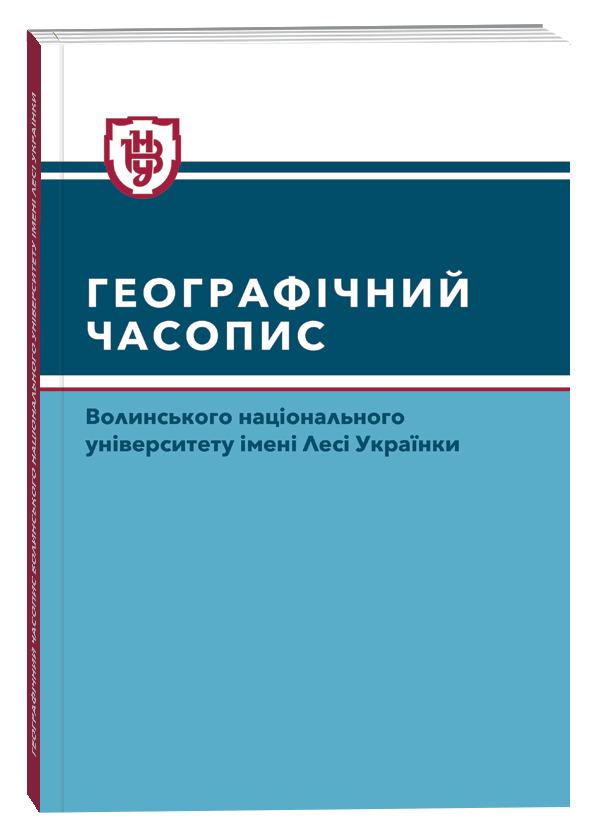MAPPING OF THE BORDERS OF EUROPE AS A WAY TO SOLVE THE PROBLEM OF UNIFICATION AND IDENTIFICATION OF A PART OF THE WORLD
DOI:
https://doi.org/10.32782/geochasvnu.2024.4.01Keywords:
Europe, borders, part of the world, geo-environment, territorial-aquatorial integrity, identification, demarcationAbstract
Peculiarities of the demarcation of Europe relative to other parts of the world have been studied in order to identify it as a territorial-aquatorial subdivision of the regional level of the planet and the basis in the system of hierarchical subordination of spatial-territorial units (elements, subdivisions) of the planetary and regional levels. The research is based on the complex use of general scientific and special scientific methods. In particular, a number of methods (retrospective, chronological, periodization, comparative-geographical, historical-geographical, dialectical and structural-functional) and approaches (geospatial planetary, block-hierarchical, individual, typological, etc.). The identification of integral territorial systems at the level of part of the world is based on the landscape-genetic principle, the method of typological zoning, cartographic modeling, and the principle of natural-anthropogenic compatibility. The experience of drawing the borders of Europe as a kind of territorial-aquatorial space of the Earth is summarized and systematized. The problems of marking the border of Europe were identified and proposals were made for their solution through the highlighting of methodological approaches and the appropriate presentation of the results of demarcation with border landmarks. A border has been established – an outer contour that separates Europe from the rest of the world. Such a cartographic representation of the borders of Europe in general creates an idea of the localization of this part of the world on the planet's amphibious surface and is a collective reproduction of the spatio-temporal organization of earthly realities and the social experience of the development of the geoenvironment. The use of Europe as a geographical projection on the Earth's surface lays the groundwork for an agreed, standard grouping of states by regions with clear territorial and water coverage and characteristics (area, distance, etc.) primarily in the scientific and educational space. Clarification and prospective standardization of European borders will contribute to the harmonization of materials in textbooks and manuals on geography, history, cultural studies, political science, reference literature, encyclopedias, atlas maps, etc.
References
Блій Г. де, Муллер П., Шаблій О. Географія. Світи, реґіони, концепти = Geography. Realms, Regions, and Concepts ; [пер. з англ.: Д. Олесневич та ін.]. Київ : Либідь, 2004. 738 c.
Бобра Т.В. Проблема вивчення геоекотонів та екотонізації геопростору у сучасній географії. Вчені записки ТНУ. Географія. 2004. Т. 17 (56), № 3. С. 35‒43.
Гордієнко В.В., Гордієнко Л.Я. Мантійні гравітаційні аномалії регіонів Євразії, Північної Америки та Атлантики. Геологія і корисні копалини Світового океану. 2023. Т.19, № 2 (72). C. 49–62. DOI: https://doi.org/10.15407/gpimo2023.02.049
Гришанков Г.Є. Вступ у фізичну географію: предмет та метод. Київ : Тов-во «Знання», 2001. 249 с.
Гудзевич А.В. Регіональна фізична географія (Європа та Азія). Вінниця : Вінндрук, 2005. 464 с.
Гудзевич А.В. Проблеми історизму в природно-географічному поділі світу. Історична географія: початок ХХІ століття. Вінниця : ПП «Вид-во «Теза», 2007. С. 137–141.
Гудзевич А.В. Просторово-часова організація сучасних ландшафтів: теорія і практика. Вінниця : Віндрук, 2012. 432 c.
Гудзевич А.В. Частина світу: проблема визначення та використання. Проблеми безперервної географічної освіти і картографії. Харків : ХНУ ім. В.Н. Каразіна, 2014. Вип. 20. С. 28–32.
Гудзевич А.В. До питання загальноприйнятих понять у географії. Наукові записки Вінницького державного педагогічного університету імені Михайла Коцюбинського. Серія : Географія. 2016. Вип. 28. № 1–2. C. 103–113.
Жирнов А.М. Морфоструктура дна Атлантики та Серединно-Атлантичного хребта. Геологія і корисні копалини Світового океану. 2019. Т. 15, № 1 (55). С. 47–62. URL: https://doi.org/10.15407/gpimo2019.01.047 (дата звернення: 12.05.2024).
Козаченко Г.І. Методологічні засади дослідження географічних меж та їх відображення на картах. Вісник геодезії та картографії. 2008. № 6 (57 ). С. 17–24.
Мольчак Я.О., Ільїн Л.В. Загальне землезнавство: навч. посіб. Луцьк : Вид-во Волин. держ. ун-ту ім. Лесі Українки «Вежа», 1997. 232 с.
Павловська Т.С., Ковальчук І.П. Геоморфологія : навч. посіб. для студентів закладів вищої освіти. Луцьк : Вежа-Друк, 2022. 348 с.
Петлін К.В. Структура і просторове функціонування ландшафтних меж. Гідрологія, гідрохімія і гідроекологія. 2002. Т. 4. С. 250–252.
Савчук І.Г. Словник суспільної географії. URL: https://geohub.org.ua/geography (дата звернення: 28.04.2024).
Стародубов А. Реальні кордони уявного континенту (про східну межу Європи). 2021. URL: https://site.ua/andriy.starodub/realni-kordoni-uyavnogo-kontinentu-pro-sxidnu-mezu-jevropi-i083gjg (дата звернення: 22.04.2024).
Топчієв О.Г. Новий погляд на географію: географічні імперативи. Український географічний журнал. 2022. № 3. C. 3–10. DOI: https://doi.org/10.15407/ugz2022.03.003.
Топчієв О.Г., Мальчикова Д.С., Яворська В.В. Регіоналістика: географічні основи регіонального розвитку і регіональної політики. Херсон : Олді-Плюс, 2015. 372 с.
Anděl J., Bláha J., Bičík I. The typology of the world’s macro-regions. Rev. Roum. Géogr. / Rom. Journ. Geogr. 2021. Vol. 65. № 2. S. 187–201.
Baerwald T.J. Prospects for Geography as an Interdisciplinary Discipline. Annals of the American Association of Geographers. 2010. Vol. 100. Is. 3. P. 493–501.
Bassin M. Russia Between Europe and Asia: The Ideological Construction of Geographical Space. Slavic Review. 1991. Vol. 50. Is. 1. P. 5–7.
Bassin M., Laruelle M., Glebov S. Between Europe and Asia: The Origins, Theories, and Legacies of Russian Eurasianism. University of Pittsburgh Press. 2015. 288 p. DOI: https://doi.org/10.2307/j.ctt15nmjch.
Blakey J. The politics of scale through Rancière. Progress in Human Geography. 2021. 45 (4). P. 623–640. DOI: https://doi.org/10.1177/0309132520944487.
Dadson S.J. Geomorphology and Earth system science. Geological Society. London, Memoirs. P. 99–108. DOI: https://doi.org/10.1144/M58-2021-9
De Miguel R. Europe in a global context: Eurogeo and the role of geography and european geographers. European Journal of Geography. 2019. Vol. 10. Is. 4. Р. 160‒176.
Ferretti F. History and philosophy of geography I: Decolonising the discipline, diversifying archives and historicising radicalism. Progress in Human Geography. 2020. Vol. 44. Is. 6. P. 1161–1171. DOI: 10.1177/0309132519893442.
Kahn S., Richard Y. Unthought and unrepresentable? The European territorial paradox. European Journal of Geography. 2020. Vol. 11. Is. 1. Р. 124‒139. DOI: https://doi.org/10.48088/ejg.s.kah.11.1.124.139.
Niemets K.A., Sehida K. Yu., Niemets L.M., Kravchenko K. O., Kobylin P.V.,. Telebienieva Ie. Yu, Kluchko L. V. Methodology of human-geographical researches: contemporary approaches and methods. Visnyk of V.N. Karazin Kharkiv National University. Series "Geology. Geography. Ecology". 2022. № 56. P. 143–158. DOI: https://doi.org/10.26565/2410-7360-2022-56-10.
Physical map Europe. URL: https://www.mapsofworld.com/physical-map/europe.htm (дата звернення: 23.04.2024).
Sheppard E. Geography and modern situation. Environment and planning. 2022. F, 1 (1). P. 14–25. DOI: https://doi.org/10.1177/26349825221082164
The dictionary of physical geography / ed. by David S.G. Thomas. Fourth Edition. Hoboken, NJ : John Wiley & Sons Inc., 2016. 614 p.
The world factbook (archive for 2023) World map. URL: https://www.cia.gov/the-world-factbook/about/archives/2023/countries/world/map (дата звернення: 13.05.2024).
Vis B.N. Understanding by the Lines We Map: Material Boundaries and the Social Interpretation of Archaeological Built Space. Digital Geoarchaeology. Natural Science in Archaeology book series (Archaeology) Springer, Cham. 2018. P. 81‒105. DOI: https://doi.org/10.1007/978-3-319-25316-9_6.
Wang N., Cheng W., Wang B., Liu Q., Zhou Ch. Geomorphological regionalization theory system and division methodology of China/ N. Wang,. Journal of Geographical Sciences. 2020. Is. 30 (2). P. 212–232. DOI: https://doi.org/10.1007/s11442-020-1724-9
World Geographical Encyclopedia. Vol. 4 (Europe) / ed. by Sybil P. Parker. New York : McGraw-Hill, 1995. 350 р.







